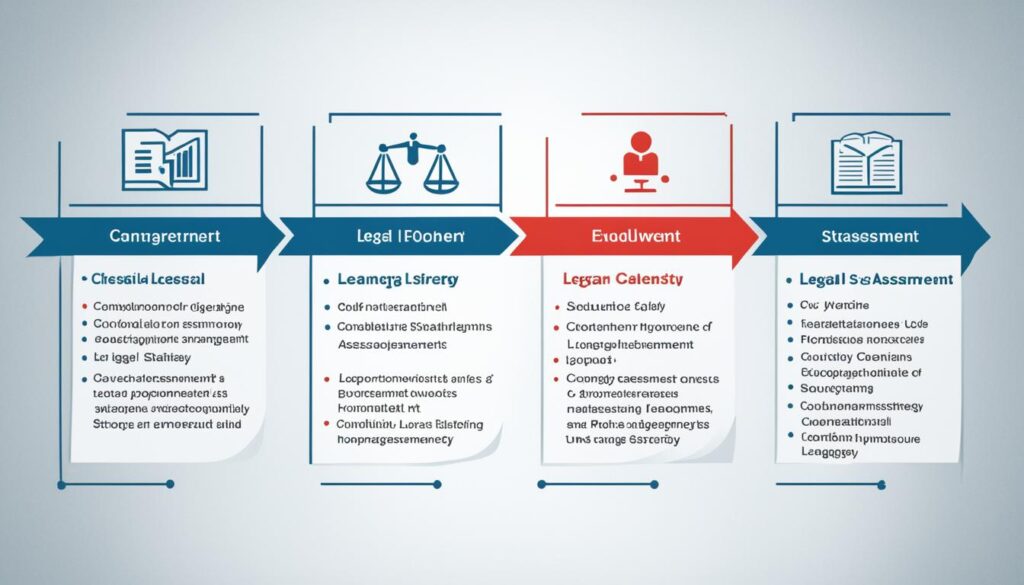Is your business ready for the storm of lawsuits that could damage its reputation? In today’s complex world, companies face many legal risks. These risks can hurt their reputation and success1. It’s important to know how to assess these risks and protect our reputation.
Litigation risk is more than just legal fights. It can hurt our financial health, brand image, and how we operate1. By having clear rules, getting expert legal advice, and building a strong legal team, we can lower our risk of lawsuits1. Remember, our reputation is very valuable, making up 70% to 80% of our market value2.
We need to be proactive in assessing and managing risks. This means keeping lawyer talks private and looking into other ways to solve disputes1. By doing this, we protect our reputation and attract the best employees and keep customers loyal2.
Key Takeaways
- Litigation risks affect businesses of all sizes and industries
- Clear policies and legal advice are crucial for prevention
- Strong legal teams and confidentiality are key in risk management
- Alternative Dispute Resolution can be less costly and time-consuming
- Reputation management is vital, impacting market value and customer loyalty
- Proactive risk assessment and mitigation strategies are essential
Understanding the Impact of Litigation on Business Reputation
Litigation can really hurt a company’s reputation and how people see it. Legal fights can make customers trust you 15% less and harm your brand image by 60%3. This loss of trust can also lead to 20% fewer loyal customers and a 25% drop in how people view your brand3.
Legal battles can hit small businesses hard, especially if they don’t have much money. Most of a company’s value comes from things like brand reputation and goodwill, making them easy targets for damage4. So, it’s crucial for businesses to keep their reputation safe during legal fights.
Reputation risks don’t stop at the start of a lawsuit. They can keep going through the whole legal process. Things like internal talks and witness statements can hurt your reputation even more5. Even winning a case might not shield your company’s image from damage. This shows how important it is to think about how you might look to others early on.
“Reputation is like fine china: expensive to acquire, fragile to maintain, and sometimes impossible to repair when broken.”
To lessen the blow of litigation, companies should:
- Do studies on how people see you after the lawsuit
- Talk to stakeholders early and often
- Have strong plans for how to communicate
- Focus on helping the community and being good corporate citizens
These actions can make people see you better by 25% and trust you 20% more3.
Knowing how lawsuits can affect a business’s reputation helps companies plan better. They can work on keeping their brand safe and valuable.
Key Issues That Can Harm a Company’s Reputation During Litigation

Legal issues can really hurt a company’s reputation. We’ve seen that 90% of customers don’t want to buy from companies with bad reputations6. This shows how important it is to manage your reputation well during legal fights.
One big worry is forgetting what the company stands for during legal fights. This can make people see the company in a bad light. Another problem is talking to the public without checking with the legal team first. This can lead to mixed messages that hurt how people see the company.
Some companies think staying quiet is the best way to protect themselves. But, this can actually let bad news spread fast. The MyFitnessPal data breach is a good example of how quickly people’s views can change6.
Companies need to change how they talk based on the legal issue they’re facing. It’s important to know that people’s opinions can change faster than legal cases move forward. Being active in public relations can help shape the company’s story and keep things clear with everyone involved7.
Reputation risks can hit any business, big or small. Keeping an eye on your reputation is key to avoiding big problems6. Using tools to listen to what people are saying online can help spot threats to your image early7. This can stop small issues from getting much worse.
“Reputational risk can lead to a threat to the survival of the biggest and best-run companies, potentially wiping out millions or billions of dollars in market capitalization or potential revenues.”8
To avoid hurting your reputation during legal fights, talk openly, keep your messages the same everywhere, and have a good plan for crises. These steps can lessen the blow of legal problems and keep trust with your stakeholders.
Proactive Approaches to Managing Litigation-Related Reputational Risk
We believe being prepared is key to protecting our reputation during legal issues. Our strategy includes planning for different scenarios to spot potential problems. This helps us come up with ways to lessen the effect on our brand9.
Having a strong risk assessment plan is essential. We do simulations and exercises to train our leaders on handling criticism and explaining our legal stance9. These drills are important because 87% of executives see reputational risk as a top concern10.
We don’t just focus on the boardroom for reputation protection. We keep an eye on social media to see what people are saying about us. This helps us craft good messages and get ready for any issues.
“Every action, big or small, can impact public perception. Stakeholders expect transparency, ethical practices, and social responsibility from businesses.”
To boost our reputation management, we use tools like social listening and community engagement10. These tools help us stay open and build strong ties with our stakeholders. This is key because 81% of consumers trust a brand before buying from it10.
| Common Reputational Risks | Impact | Mitigation Strategy |
|---|---|---|
| Poor Product Quality | Loss of Sales | Proactive Communication |
| Ethical Breaches | Broken Customer Trust | Crisis Management Planning |
| Security Failures | Legal Consequences | Employee Training |
By using these proactive steps, we aim to keep our reputation safe and trust with stakeholders, even when facing legal issues11.
The Role of Communication in Mitigating Reputational Damage
In today’s digital world, a company’s reputation can change fast. That’s why it’s key to keep an eye on the digital world12. We know that good communication is key to fixing a damaged reputation during legal issues. Our plan must be ready and adapt quickly, with PR experts helping every step of the way.
It’s vital to use tools that track social media, news, and what customers say online12. This helps us catch problems early and make a plan for crisis situations. By talking to the media well, we can share the truth about legal matters while keeping public opinion in mind.

Getting stakeholders on board is key to keeping a good reputation. We make sure to find out who these people are and talk to them openly and often12. This builds trust and shows we’re a trustworthy, responsible business. When we’re in court, our PR and legal teams work together to make sure our messages support our legal goals.
Recent cases show how important strong communication is. In 2023, Delta Air Lines faced a lawsuit over claims about being carbon neutral, and Shell was sued by ClientEarth. These cases show how more companies are facing lawsuits over environmental and social issues. They also highlight the need for clear, honest communication13.
To avoid damage to our reputation, we make sure our actions match our values and we act ethically12. By following best practices and always learning, we can handle legal challenges and keep a good reputation, even when things get tough.
Litigation risks and strategies in reputation management
Managing your reputation during legal issues needs a smart plan. Good strategies keep trust with stakeholders and make clear communication plans. It’s important to link legal and communication plans to protect employees, customers, and others14.
Senior leaders are key in keeping the workforce safe and keeping the business running. A study by Weber Shandwick found CEOs are seen as the top crisis leaders. Yet, the day-to-day work is often done by lower-level staff15.

Handling legal risks is a team effort in a company. It’s important to think about how different groups like employees, financial experts, customers, suppliers, and the media see things. Some lawyers say it’s smart to balance legal worries with business plans to dodge bad publicity for a long time15.
Crisis management requires a culture of anticipation and proactive planning.
In today’s digital world, how you look online is key in handling crises. Research shows 90% of customers won’t support a business with a bad online image in a crisis. Also, 87% check reviews before choosing a local business16.
| Reputation Management Tool | Purpose |
|---|---|
| RM Studio | Risk assessment |
| Mention | Online conversation monitoring |
| Google Analytics | Website traffic analysis |
Using these tools and strategies helps us lower legal risks and keep trust with stakeholders when things get tough.
Developing a Strong Legal Risk Management Framework

A strong legal risk framework is key for businesses to handle legal issues. We must use a systematic way to find, check, and lessen legal risks17.
Regular risk audits are crucial. They help us find legal problems early and fix them before they get worse. This way, we can avoid expensive court cases and keep our company’s good name18.
Our strategy for managing risks should include:
- Creating clear policies and steps
- Getting advice from legal experts
- Keeping accurate records
- Training staff on legal rules
- Using strong ways to manage documents
It’s important to keep updating our policies as laws change. This keeps us in line with the law and helps avoid fines and damage to our reputation17.
Using legal technology helps us manage risks better. These tools can do tasks automatically, keep track of documents, and help us see where we’re spending on legal stuff. This lets our legal team focus on big-picture risk management and prevention17.
“An ounce of prevention is worth a pound of cure.”
Putting legal risk management first protects our business from big financial losses, bad reputation, and fines. A full plan that includes checking risks, updating policies, and using technology can really lower our chances of legal trouble19.
Leveraging Technology for Better Risk Insights and Decision-Making
In today’s fast-paced business world, risk management technology is key. It helps spot and reduce legal risks. Companies are now using data analysis tools to sharpen their risk management plans20.
AI in risk assessment has changed how we predict legal outcomes and check contracts. These technologies let us see the chances of winning cases and find tricky clauses easily20.
Cybersecurity and information governance are vital for managing legal risks. Using strong data protection like encryption and access controls keeps sensitive info safe from hackers20.
Risk management software makes workflows more consistent and automated, boosting efficiency. Data management systems securely collect, store, and manage risk data. Automation tools also make repetitive tasks easier21.
“Collaboration is key in developing comprehensive risk mitigation strategies.”
Cloud computing offers flexible infrastructure for risk management, promoting teamwork and saving money. It lets small businesses streamline risk assessment, keep an eye on risks in real-time, and make decisions based on data21.
To use technology well in risk management, we suggest regular checks, easy-to-use software, and training for employees. Digital twin technology creates fake versions of real situations to check for weak spots accurately2122.
| Technology | Benefits |
|---|---|
| AI and Machine Learning | Enhanced data analysis, predictive insights |
| Cloud Computing | Scalability, collaboration, cost-efficiency |
| Digital Twin | Accurate risk assessment, scenario planning |
By using these tech advances, we can craft more thorough risk mitigation plans. This leads to better decisions in managing legal risks22.
Conclusion
Managing risks and protecting your reputation is key for business success today. We’ve learned how risks, ethical issues, and bad crisis handling can hurt a company’s image23. Keeping a good reputation is important because it builds trust with customers, investors, and workers, giving your business an edge23.
Being proactive helps in dealing with legal issues and keeping your company’s image safe. Being open helps build trust and credibility with people, making it easier for them to choose your products and services24. Also, 76% of people check online reviews when looking for local businesses, showing how important a good online image is25.
Using a strong legal risk management plan and technology for better insights helps businesses stay ahead. Being open in communication and showing social responsibility can make your company stand out from others24. Remember, 50% of job seekers wouldn’t work for a company with a bad reputation, even if it paid more, showing how big of an impact reputation has on hiring25. In the end, balancing new ideas with careful planning is crucial for fighting off legal, financial, and reputational risks and keeping your business growing and successful.
FAQ
What is litigation risk, and why is it important for businesses?
How can litigation impact a business’s reputation?
What are the key issues that can harm a company’s reputation during litigation?
How can businesses take a proactive approach to managing litigation-related reputational risk?
What is the role of communication in mitigating reputational damage during litigation?
What strategies can help manage reputation during litigation?
How can businesses develop a strong legal risk management framework?
How can technology help in better risk insights and decision-making?
Source Links
- Managing Litigation Risk: Practical Tips for Businesses | – https://lommen.com/managing-litigation-risk-practical-tips-businesses/
- Reputation and Its Risks – https://hbr.org/2007/02/reputation-and-its-risks
- How to Recover Your Reputation After a Business Litigation – https://thedoylelawoffices.com/blog/reputation-after-business-litigation/
- Impact of Lawsuits and Litigation on Brand Image – https://www.supplywisdom.com/resources/impact-of-lawsuits-and-litigation-on-brand-image
- Protecting Your Reputation in Commercial Litigation – Carter-Ruck – https://www.carter-ruck.com/insight/protecting-your-reputation-in-commercial-litigation/
- What Are the Effects of Reputational Damage – https://www.determ.com/blog/what-are-the-effects-of-reputational-damage/
- Reputational Risk Management – Strategies to Build Trust and Credibility With ORM – https://www.radarr.com/blog/reputational-risk-management-strategies-to-build-trust-and-credibility/
- Reputational Risk: Definition, Dangers, Causes, and Example – https://www.investopedia.com/terms/r/reputational-risk.asp
- Managing Reputational Risk in Litigation – Argyle – https://argyleprusa.com/insight-and-inspiration/managing-reputational-risks-in-litigation/
- 6 Ways to Manage Reputational Risk? – https://konnectinsights.com/blogs/expert-strategies-for-reputation-risk-management/
- A Comprehensive Guide to Reputational Risks | SafetyCulture – https://safetyculture.com/topics/reputation-management/reputational-risk/
- What are the most effective strategies for minimizing reputational risks? – https://www.linkedin.com/advice/0/what-most-effective-strategies-minimizing-reputational-o8tle
- Managing Litigation and Reputation Risks as Corporate ESG Claims Are Challenged – https://www.linkedin.com/pulse/managing-litigation-reputation-risks-corporate-esg-claims-kim-polley-kqkle
- PDF – https://ideas.llorenteycuenca.com/wp-content/uploads/sites/5/2015/04/150429_DI_report_reputation_litigations_ENG.pdf
- PDF – https://webershandwick.com/uploads/news/files/Legal_ExecSummary_Global.pdf
- Strategies for Managing Online Reputation Crises in the Legal Sector: A Comprehensive Guide – Market My Market – https://www.marketmymarket.com/legal-marketing/strategies-for-managing-online-reputation-crises-in-the-legal-sector-a-comprehensive-guide/
- Corporate Legal Risks – Things every Corporate Lawyer should know. – https://www.linkedin.com/pulse/corporate-legal-risks-things-every-lawyer-should-know-chedayan
- Legal Risk Assessment: Essential Steps For Business Litigation Preparation – The Jacobs Law, LLC – https://thejacobslaw.com/legal-risk-assessment-essential-steps-for-business-litigation-preparation/
- Legal Risk Management: A Comprehensive Guide For Businesses – https://www.volody.com/resource/legal-risk-management-a-guide-for-business/
- How Technology Enables Better Legal Risk Management – Consult CRA – https://www.consultcra.com/how-technology-can-enable-better-legal-risk-management/
- Leveraging Technology For Better Risk Management – FasterCapital – https://fastercapital.com/topics/leveraging-technology-for-better-risk-management.html
- Leveraging technology crucial for effective risk mitigation – https://kpmg.com/sg/en/home/insights/2024/06/leveraging-technology-crucial-for-effective-risk-mitigation.html
- Reputational Risk: What it is, Types + Tips to Manage – https://www.questionpro.com/blog/reputational-risk/
- 7 Proven Strategies For Corporate Reputation Management – https://www.realnewspr.com/blog/7-proven-strategies-for-effective-corporate-reputation-management/
- Reputation management: The essential guide to protecting your brand – https://sproutsocial.com/insights/reputation-management/

